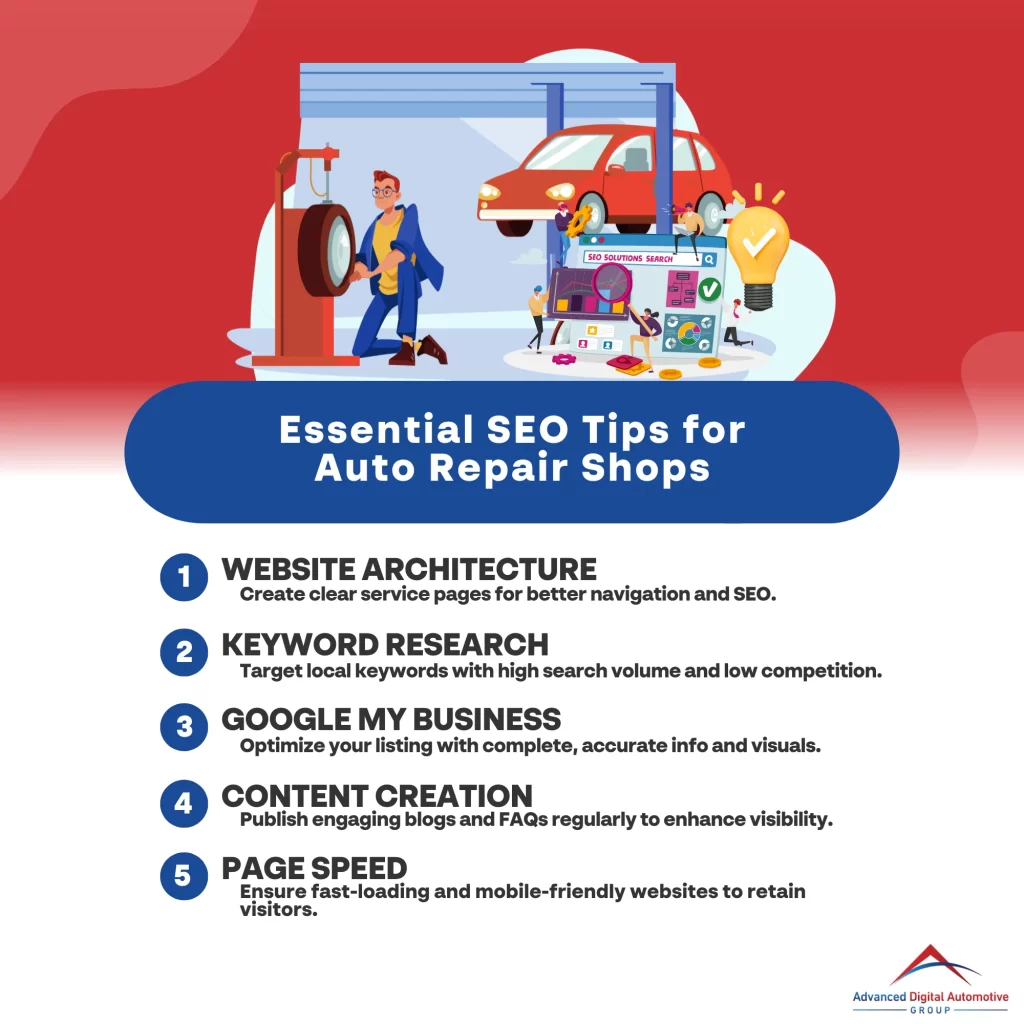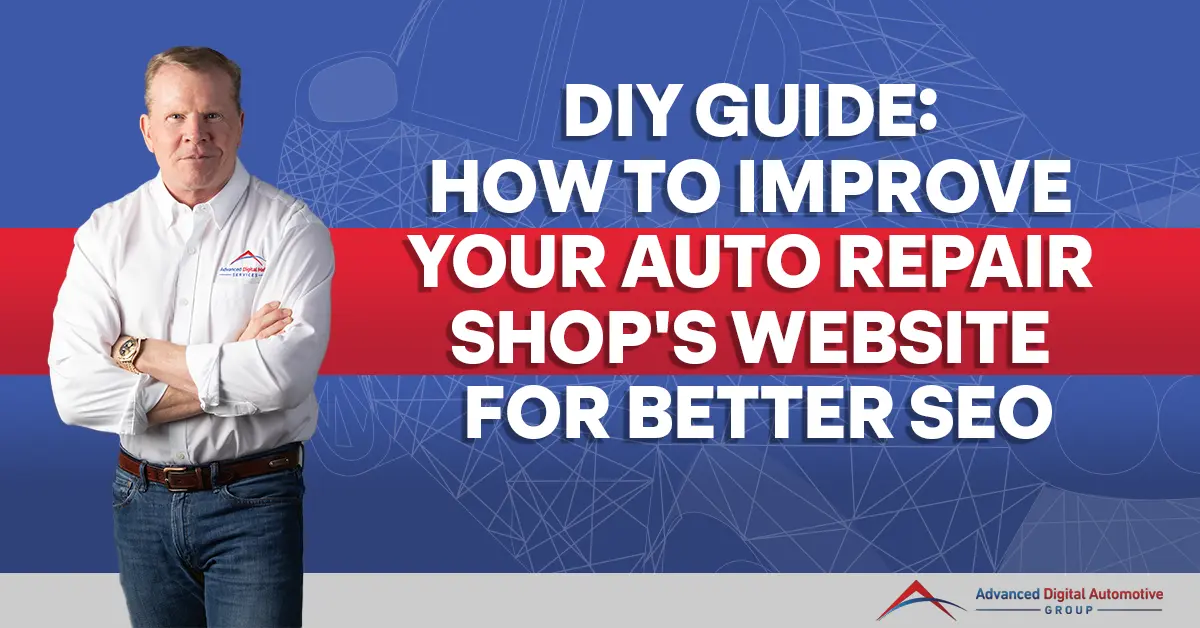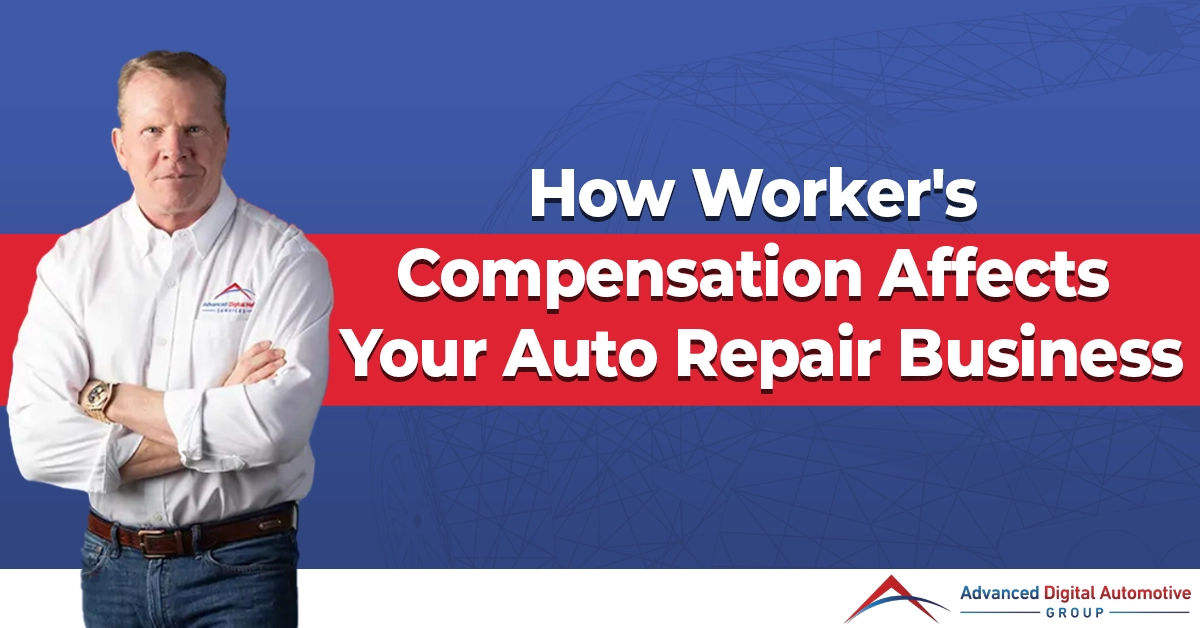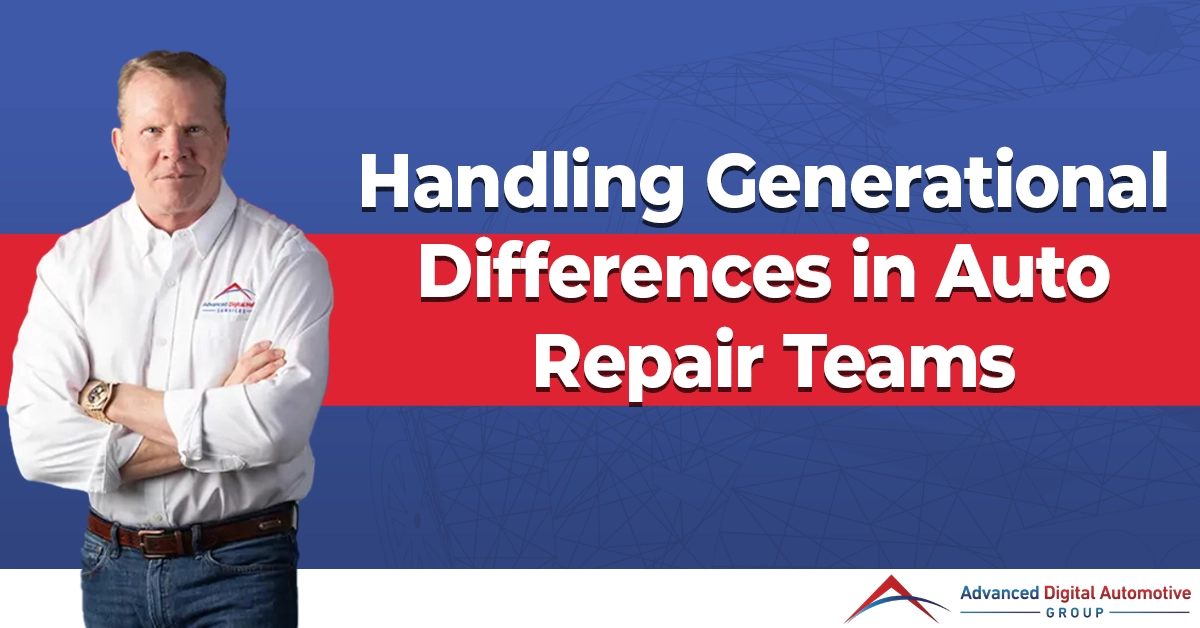To improve your auto repair shop’s website for better SEO, start with a solid site architecture that clearly defines your service areas. Conduct thorough keyword research to find high-volume, low-competition terms and incorporate them into your content. Create dedicated pages for each service, ensuring mobile-friendliness and fast loading times for the best user experience. Strengthen your local presence by optimizing your Google My Business account and securing relevant backlinks. Engage visitors with regular blog posts and internal links that guide them through your site. There’s much more to explore that can elevate your online visibility and drive traffic.

Key Takeaways
- Establish a clear website architecture with dedicated pages for each service to enhance user experience and SEO performance.
- Conduct thorough keyword research to identify local and relevant keywords, clustering them into content topics for effective marketing.
- Create valuable, engaging content regularly while optimizing meta descriptions and headings for improved search visibility.
- Optimize your Google My Business listing with accurate information, high-quality images, and regular updates to boost local search presence.
- Monitor website performance using tools like Google Search Console to adapt your SEO strategies based on user engagement and visibility metrics.
Why Is SEO Important for Auto Repair Shops?
SEO is vital for auto repair shops because it directly impacts your visibility and customer acquisition. In today’s digital age, customers search online for services, and if your shop doesn’t rank high in search engine results, you’re likely missing out on potential business.
By implementing effective SEO strategies, you position your shop as a leader in the industry, attracting customers actively seeking your services.
Local search optimization is especially significant, as it drives foot traffic to your shop. When your website appears in local searches, it increases the likelihood of customers choosing you over competitors.
A strong online presence not only enhances visibility but also builds customer trust and loyalty.
Managing your online reputation through reviews and consistent engagement with customers creates lasting relationships. Customers are more inclined to choose a shop with a solid online reputation, so investing in SEO isn’t just about visibility; it’s about establishing trustworthiness.
Fundamentally, SEO isn’t merely an option but a necessity for sustainable growth and competitive advantage in the auto repair industry. Without it, you risk falling behind in an increasingly digital marketplace.
How to Implement SEO for Automotive Repair Shop Websites
To effectively implement SEO for your automotive repair shop website, start by establishing a solid website architecture that highlights your core services.
Next, perform thorough keyword research to identify terms your potential customers are searching for.
Once you have your keywords, cluster them into relevant content topics to guide your marketing efforts.
Step 1: Create A Compelling Website Architecture That Defines Your Core Service Areas
When building your auto repair shop’s online presence, creating a compelling website architecture is vital for defining your core service areas. Start by organizing your site into clear, distinct sections that highlight the services you offer, like oil changes, brake repairs, and tire servicing.
This structure not only improves user experience but also aids search engines in understanding your business better.
Utilize a logical hierarchy that prioritizes important pages. Your homepage should serve as a gateway, leading visitors to specific service pages. Each service area should have its own dedicated page with detailed content that explains the services, benefits, and any relevant promotions.
Incorporate internal linking to connect related pages, which helps keep users engaged and encourages them to explore your offerings. Ensureyour website is mobile-friendly, as many customers search for auto repair services on their phones.
Lastly, implement a clear navigation menu that allows visitors to find information quickly. A well-structured website architecture not only enhances user experience but also boosts your search engine visibility, making it easier for potential customers to discover your services.
Step 2: Perform Keyword Research
Next, use keyword research tools like Google Keyword Planner or SEMrush to analyze search volume and competition for these terms.
Look for keywords that strike a balance between high search volume and lower competition; these are your golden opportunities.
Don’t forget to incorporate local keywords, such as “auto repair in [Your City],” to attract nearby customers.
This local focus not only boosts your visibility but also drives foot traffic to your shop.
Step 3: Cluster Keywords And Generate Content Topics
Once you’ve established your clusters, prioritize content topics that address common customer queries. This not only helps in creating relevant blog posts and service pages but also improves your site’s authority in search engines.
Consider crafting how-to guides, troubleshooting articles, or service comparisons that incorporate these keywords.
Next, make certain that each piece of content effectively includes keywords from your clusters, enhancing both readability and SEO performance.
This method allows you to create a cohesive narrative around your services, making it easier for potential customers to find the information they need.
Step 4: Create a Content Calendar
Creating a content calendar is a strategic move to enhance your auto repair shop’s SEO efforts. By planning your content in advance, you guarantee consistent posting and align your topics with seasonal trends, promotions, or industry events. This organization helps you focus on relevant keywords identified in your previous research, thereby improving your site’s visibility.
Start by outlining key themes based on your cluster keywords. For example, you might create a schedule that includes how-to guides, maintenance tips, and service promotions. Allocate specific publishing dates for each topic to maintain momentum and audience engagement.
Be certain to include a mix of content types, such as blog posts, videos, and social media updates, to cater to various audience preferences.
Also consider local events or holidays that may impact vehicle maintenance, guaranteeing your content stays relevant to your community.
Step 5: Establish a Content Production Process
Establishing a streamlined content production process is essential for maximizing your auto repair shop’s SEO efforts. Begin by defining clear roles within your team, guaranteeing that each member knows their responsibilities in content creation, editing, and publishing. This clarity creates accountability and enhances efficiency.
Next, develop a content calendar that aligns with your overall marketing strategy. Your calendar should include topics based on keyword research, seasonal events, and customer inquiries. This targeted approach not only maintains a consistent posting schedule but also addresses your audience’s interests and needs.
Regularly review your content performance metrics to identify what resonates with your audience. Use these insights to refine your future content topics and formats. Consider incorporating diverse content types, such as blog posts, videos, and infographics, to engage various customer preferences.
Lastly, maintain a feedback loop within your team to discuss successes and areas for improvement. This ongoing evaluation will help you adapt to changing trends and guarantee your content remains relevant.
Step 6: Create SEO-Optimized Content
Next, incorporate these keywords naturally into your website’s content, including service pages, blog posts, and FAQs.
Aim for a balance: while keywords are essential, your content must remain engaging and informative. Write with your audience in mind, addressing their concerns and providing valuable insights related to auto repair.
Consider creating regular blog posts that cover common issues, maintenance tips, and seasonal advice. This not only helps with SEO but positions your shop as a knowledgeable authority in the field.
Additionally, optimize meta descriptions and headings for better visibility in search results.
Step 7: Optimize Internal Linking
While many auto repair shops focus on external SEO tactics, optimizing internal linking can greatly enhance your website’s overall performance and user experience. Internal links connect different pages within your site, helping both search engines and users navigate your content effectively. This strategy not only boosts your SEO but also encourages visitors to explore more of your services.
Start by identifying key pages, such as your service offerings and blog posts. Use relevant anchor text that clearly describes the linked content—this aids in both SEO and user understanding. For instance, if you have a page about brake repairs, link to it from related content, like articles on car maintenance.
Additionally, guarantee your internal links are structured logically. A well-organized hierarchy allows search engines to understand your site’s layout better, improving crawl efficiency. Avoid excessive linking; focus on quality over quantity. Aim for a balance that guides users without overwhelming them.
Regularly review and update your internal links as your content evolves. This not only keeps your site fresh but also helps maintain relevance for both users and search engines, ultimately driving more traffic to your auto repair shop.
Step 8: Acquire Backlinks and Local References
Acquiring backlinks and local references is vitalfor boosting your auto repair shop’s online authority and visibility. Backlinks act as endorsements from other websites, signaling to search engines that your content is credible and valuable.
Start by reaching out to local businesses, such as car dealerships or parts suppliers, and propose partnerships that benefit both parties. You can also engage with local bloggers or influencers who might be interested in your services and can share your content.
Listing your shop in local directories alsoenhances your visibility andcontributes to your backlink profile. Aim for reputable sites related to automotive services or community resources.
Consider participating in local events or sponsoring community activities, as these can generate references from local news sites or blogs, further highlightingyour authority.
Step 9: Optimize Page Speed and Website Experience
To guarantee your auto repair shop stands out online, optimizing page speed and overall website experience is vital. A fast-loading website improves user satisfaction and reduces bounce rates, keeping potential customers engaged longer. Aim for a loading time of under three seconds; this is essential for retaining visitors and improving your search engine rankings.
Start by compressing images and utilizing modern formats like WebP to decrease file sizes without sacrificing quality. Minimize JavaScript and CSS files and consider using a content delivery network (CDN) to improve loading times across various locations.
Alsoverify your website is mobile-responsive. Many users search for auto repair services on their smartphones, so a seamless mobile experience can greatly increaseuser engagement and conversion rates.
Don’t forget to streamline navigation. A clear, intuitive layout helps users find what they need quickly, leading to a more satisfying experience.
Regularly test your page speed with tools like Google PageSpeed Insights. This will provide insights into areas needing improvement, allowing you to maintain a superior website experience.
Step 10: Track Rankings Using Google Search Console
Tracking your rankings is key to understanding the effectiveness of your SEO efforts. Google Search Console is a powerful tool that helps you monitor how your auto repair shop’s website performs in search results. Start by verifying your site ownership and submitting your sitemap. This guarantees Google can crawl and index your pages efficiently.
Once set up, focus on the Performance report. This section shows you essential metrics like total clicks, impressions, average position, and click-through rate (CTR) for your targeted keywords. Analyze which keywords are driving traffic and which need more optimization. If you notice a dip in rankings, investigate potential issues like content quality, page speed, or even algorithm updates.
Utilize the Coverage report to identify any indexing problems that may affect your visibility. Fixing these issues promptly can prevent lost traffic.
Regularly check the Search Console for new insights, as this will help you adapt your strategy over time. By consistently tracking your rankings, you’ll be able to make informed decisions and refine your SEO tactics, ultimately boosting your auto repair shop’s online presence and attracting more customers.
Step 11: Optimize Your Auto Repair Shop’s Local Google My Business Account
Optimizing your auto repair shop’s Google My Business (GMB) account is a key step to enhancing local visibility and attracting nearby customers. Start by ensuring that all your business information is accurate and complete, including your address, phone number, and operating hours. This information helps Google display your shop prominently in local search results.
Next, choose relevant categories for your business. Selecting the right categories helps Google understand your services, making it easier for potential customers to find you.
Don’t forget to add high-quality images that showcase your shop, services, and any other relevant visuals. Visual content can greatly increase engagement and interest.
Encourage satisfied customers to leave positive reviews on your GMB profile. Responding to reviews, both positive and negative, demonstrates your commitment to customer service and builds trust with potential clients.
Regularly post updates, offers, and promotions to keep your audience engaged.
Step 12: Focus on the Ultimate Goal — Leads and Conversions
Achieving your ultimate goal of generating leads and conversions for your auto repair shop hinges on effective SEO implementation. To drive results, focus on attracting high-intent traffic—those potential customers actively searching for services like yours.
Start by optimizing your website with relevant keywords that align with what your target audience is searching for. This helps improve your visibility in search engine results, positioning you as a reliable choice.
Utilize local SEO strategies, such as optimizing your Google Business Profile, to capture nearby customers. Make sure your website offers a seamless user experience, making it easy for visitors to navigate, find information, and book appointments.
Don’t underestimate the power of online reviews. Encourage satisfied customers to leave positive feedback, as this builds trust and enhances your online reputation.
Frequently Asked Questions
How Long Does It Take to See SEO Results?
You’ll typically see initial SEO results within a few months. Consistent efforts and adjustments can lead to sustained growth, increasingyour online visibility and attracting more customers over time. Patience and strategy are key.
What Are the Best Tools for Tracking SEO Performance?
To track SEO performance effectively, you’ll want to use tools like Google Analytics and SEMrush. They provide insights on traffic, rankings, and engagement, enabling you to refine your strategies and improve overall results.
Can Social Media Influence SEO Rankings?
Yes, social media can influence SEO rankings. By sharing content and engaging with your audience, you drive traffic to your website, increase brand visibility, and enhance your online reputation, all of which positively impact search rankings.
How Often Should I Update My Website Content?
You should update your website content regularly, ideally every few weeks. This keeps your site fresh, improves SEO rankings, and engages visitors, ultimately attracting more customers and enhancing your online presence in the competitive market.
What Are Common SEO Mistakes to Avoid?
Avoid keyword stuffing, neglecting mobile optimization, and ignoring analytics. These pitfalls can blindfold your efforts, limiting visibility and growth. Stay sharp, and keep your strategies aligned with best practices.
Conclusion
In the digital landscape, your website is like the engine of your auto repair shop—without proper tuning, it won’t run smoothly. By implementing these SEO strategies, you’re not just fixing the surface; you’re enhancing performance and driving growth. Think of your online presence as a well-oiled machine, attracting high-intent customers and strengthening loyalty. Keep refining your approach, and watch as your shop transforms into a trusted go-to destination for automotive needs in your community.









